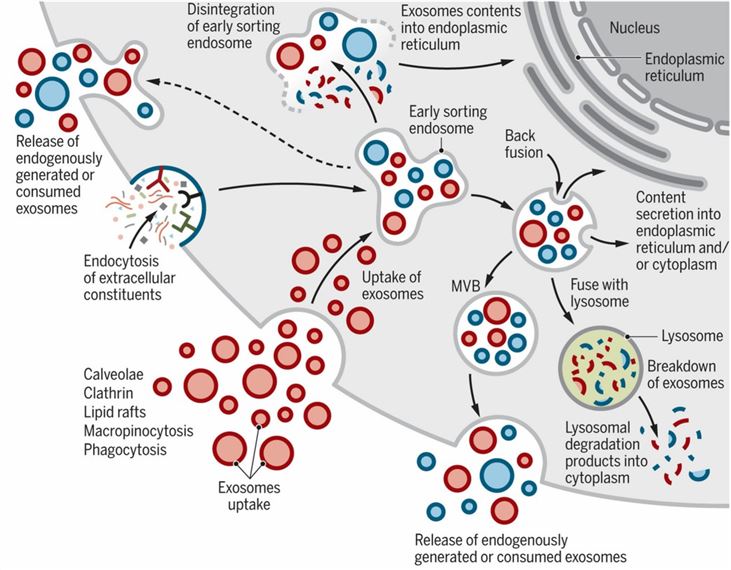Exosome Pharmacokinetic Characteristic Summary
Excelltent circulation and metabolism are key to exosomes and their use as safe delivery vehicles for stable cargo encapsulation and transfer, with unique potential for drug delivery, cell therapy, and diagnostics. Creative Biolabs draws on a deep insight into exosome pharmacokinetics as well as provides research services related to exosome isolation and functional development.
Exosome Circulation and Uptake
It is the lipids and proteins composed by the exosomes that are the main factors influencing their pharmacokinetic properties and play a role in enhancing bioavailability and minimizing adverse effects. As exosomes originate in natural cells and tissues, they are able to achieve a stable presence in circulation and protect the activity of the encapsulated cargo. When the administration of exosomes in diverse manners, including intravenous injection, oral administration, nebulized inhalation, and nasal drip, with the exception of a few exosomes that interact directly with endothelial cells in close proximity to the vessel wall, the majority enter the blood circulation and reach other parenchymal organs without eliciting a strong immune response, giving a plasma half-life of only 2-4 min. They are then, taken up in several ways, including direct fusion, the lattice protein/small fossil protein-dependent cytokinesis pathway, macropinocytosis, phagocytosis, and lipid raft-mediated endocytosis. Exosomes endocytosed by recipient cells release their cargo into the cytoplasm and re-form multivesicular bodies. In contrast, uptake by membrane fusion is the fusion of the exosomal membrane into the cytoplasmic membrane allowing for the exchange of material and signals. The level of exosome uptake depends on the recipient cell's preferences, which can be reduced by inhibiting its key proteins to lessen uptake behavior. In addition, environmental pH is another factor, with acidic environments enhancing cellular uptake by increasing the expression of exosomal surface niche protein-1.
Exosome Metabolism and Clearance
Exosome clearance is mediated by the MPS (mononuclear phagocyte system), which intersects with exosome production and uptake, resulting in a mixed intracellular exosome population consisting of endogenous and recycled exosomes. The particle size of exosomes may be one of the significant determinants of their metabolic clearance. It has been found that liver parenchymal cells capture and metabolize vesicles smaller than about 100 nm, while other larger particles are blocked outside the liver and cleared by the spleen. Due to the slight negative surface charge, MPS-mediated exosome clearance is expected to be reduced compared to positively charged nanoparticles. On the one hand, exosomes contain phosphatidylserine, a negatively charged lipid as part of exosome clearance, which is involved in exosome uptake by macrophages. On the other hand, glycosylphosphatidylinositol (GPI) anchoring the surface of expressed CD55 and CD59 protects exosomes from complement-mediated cleavage. Along with stable circulation and metabolism in normal tissues, exosomes are aggregated in tissues with lesions such as injury and inflammatory reactions. Consideration may be related to the expression of specific receptors on the exosome surface that are recognized by inflammatory cells, or may be attributed to inflammation and increased permeability of damaged tissues.
 Fig.1 Cellular journey of internalized exosomes and endogenously produced exosomes. (Kalluri & LeBleu, 2020)
Fig.1 Cellular journey of internalized exosomes and endogenously produced exosomes. (Kalluri & LeBleu, 2020)
Exosomes carrying a wealth of active ingredients have a role in regulating the expression patterns of target genes and various molecular pathways, with excellent absorption, circulation, and metabolic characteristics, thus attracting widespread interest in basic and translational research. Creative Biolabs provides high-quality exosome research services to advance the application and investigation of exosomes as safe drug delivery vehicles. Please feel free to contact us.
Reference
-
Kalluri, R.; LeBleu, V.S. The biology, function, and biomedical applications of exosomes. Science. 2020, 367(6478): eaau6977.
For Research Use Only. Cannot be used by patients.
Related Services:

 Fig.1 Cellular journey of internalized exosomes and endogenously produced exosomes. (Kalluri & LeBleu, 2020)
Fig.1 Cellular journey of internalized exosomes and endogenously produced exosomes. (Kalluri & LeBleu, 2020)









